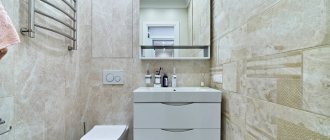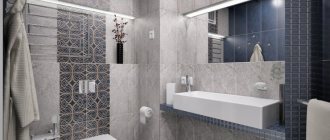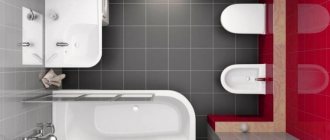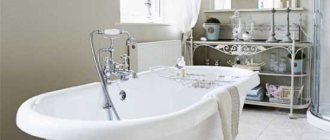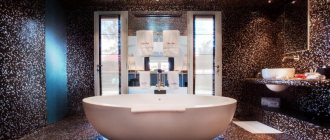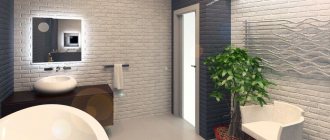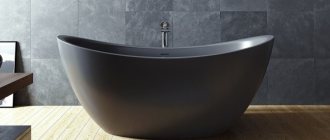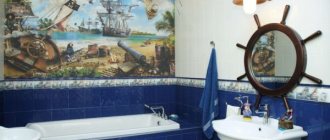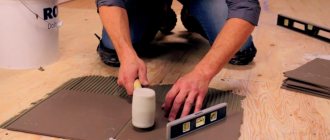Tile today is presented in a wide range, but against the backdrop of all the diversity, ceramic tile hog stands out. Due to its original design, many consumers prefer it.
Features and benefits of tiles
Hog-type tiles have several clear advantages that make them different from any other types of finishes.
- Increased resistance to moisture and temperature changes. Regardless of the level of humidity or temperature, the tile will retain its properties and appearance for a long time.
- Environmental friendliness. This type of tile is made from natural materials.
- Easy to care for. This finish is easy to clean; it is not afraid of even aggressive cleaning agents.
- Reliability. This variety has a very long service life.
- An excellent solution for finishing uneven or rough surfaces.
- Large selection of colors. This allows you to realize any design idea.
- An excellent combination with other types of finishing materials.
The wall surface, lined with a glossy “hog” with decorative beads, looks stylish and original.
“Boar” tiles can be used to decorate the entire bathroom or just to highlight the desired accents
Assortment of finishing tiles
Assortment of hog tiles for the bathroom
This type of cladding, photos of which are often found in catalogues, is most often shown in a white glossy or reddish matte finish. But this trend of any season has a lot of varieties and shades:
- a bright rich shade will decorate the bathtub and give it a stylish finish;
- decor with macro photography will create a different impression even from a small bathroom;
- tiles using a chamfer along the edge are an original and stylish solution.
Any store in the city offers to purchase cladding, but you should first figure out which one you need: with or without a chamfer. In the second case, it is better to purchase grout in a contrasting color, this will give a more original look to the wall. Inexpensive and practical finishing is distinguished not only by its quality and variety of shades.
Thanks to their small format, the tiles can “fit” even in the most limited areas. A hog-tiled bathroom will look elegant and stylish. And resistance to damage and ease of maintenance have ensured that the material is widely used not only at home, but also in restrooms of public institutions.
What kind of hog tile is this and why is it called that?
This unusual name for the material is explained by the presence of two holes at the end of the tile. These holes are covered with a blank glaze, and due to this, the finish resembles a boar's snout. This was the reason for the appearance of this name.
Today, a “hog” is a monochromatic tile of an elongated shape, close to the size of a brick.
Due to the fact that the tile has a rectangular shape, it can be used to imitate brickwork. The volume of the tile visually appears larger and more textured due to the slightly beveled end chamfer. There are models without such an edge, and in this case the contrasting grout is responsible for the texture.
Beveled bevels give the ceramic surface a more vibrant and original look
Inherent traits
Ceramic tile hog has its own unique features, one of which is the presence of a chamfer, representing a beveled edge of the end. It is this moment that emphasizes the edges, making the tiled area three-dimensional.
Fact!
The beveled chamfer does not imply the main characteristic element of the tile - the hog. In most cases, this facing material is made without a beveled edge.
But how, given the absence of the famous chamfer that makes the coating voluminous, can this effect be achieved? Designers recommend using grout that provides a transition of contrast. This work is not easy - it requires artistic flair.
Why does the tile have such a strange name - hog? This definition has stuck because there are 2 holes at the end sections (they are used for the production of tiles).
The sight of such a blank evoked positive emotions among ordinary people, reminding them of a pig’s heel. The name came to the liking of ordinary people, and is often used to this day.
A similar material in Western countries is called Metro tiles. The fashion for such a solution arose quite a long time ago, back in the 20s of the 20th century. At that time, the new art deco trend was sweeping the horizons.
Tiles were very often used to decorate the walls of facades and metro station buildings. At this moment, it is very important to recall footage from French or American films that show metro stations. These tiles are laid out in a special way - staggered.
Important!
Such a tile covering can have different types, structures, sizes, but its popularity will always be determined by its external resemblance to brickwork.
Among the several advantages of such a facing material are:
- Hog type tiles are quite strong. Unlike other types of tiles, it does not collapse as a result of critical loads.
- The material lasts quite a long time.
- Boar tiles are resistant to both high and low temperatures.
- It is resistant to moisture - this makes it possible to use it for the design of a bathroom.
- It has a dense texture, making it resistant to stains.
It is worth noting that the undoubted advantage of using detailed type tiles is the ability to lay them on uneven surfaces. This allows you to significantly reduce the time for repair and cladding work.
Tips for choosing
The most important parameter when choosing finishing materials is the size of the room. As a rule, most bathrooms cannot boast of not only large, but even medium sizes. If you choose the wrong material, there is a risk of visually making the space even smaller. To avoid this, when choosing tiles, you need to take into account the advice of professionals.
- For small rooms, it is optimal to use small tiles: this will help to visually make the space larger. Large tiles should not be used; it is better to leave them for installation in larger rooms.
- If the tiles are laid vertically, then the room visually becomes taller, the same with horizontal laying - the room will visually appear wider. In small spaces, you can also use the diagonal laying method.
- For small rooms it is better to choose light colors; these can be several matching shades.
- Large prints, photo wallpapers, large patterns - all this is suitable only for spacious bathrooms.
- For a small bathroom, you can not use any patterns at all, or make a few small accents in the form of small patterns.
- Finishing with a mirror surface will visually increase the space. It can become the basis for an entire mirror wall or part of it.
- You should not use dark or bright borders as decoration in a small bathroom; you should also avoid dividing the wall into a light upper part and a dark lower part.
In large rooms it is better to lay tiles in the classic way with offset
In a small bathroom, you can choose a diagonal “hog” installation
Tiles with a glossy surface will visually increase the space of the bathroom
Matte tiles look more expensive and dignified
In what design directions is the boar used?
Many designers use interesting tiles in their works. It helps highlight the strengths of the room and also places interesting accents in the room.
Black always looks impressive in any room
The boar is usually found in the following styles:
- Scandinavian style . The peculiarity of the style is an interesting combination of matte and glossy surfaces. The kitchen set can have reflective facades, and the apron can have discreet brickwork.
- Art Deco . The main features are restraint and monumentality. They successfully emphasize the strict lines of the finishing material. It is best to use black and white shades for this style. In addition, a white surface looks good combined with bright kitchen furniture.
A combination of matte and glossy surfaces in Scandinavian style
- Loft . This style is characterized by metal and glass details. To emphasize their beauty, the tiles are laid not only in the apron area, but also on adjacent walls.
- Country . For a simple rustic style, tiles will be a real highlight. The main thing is that as many shelves and open cabinets as possible are located on the apron.
- Classic . The cladding matches perfectly with wooden facades. All decoration should be as simple as possible to emphasize the luxurious interior of the kitchen.
Loft style - classic combination of metal and glass
Necessary Requirements
Materials for finishing a bathroom must be selected especially carefully, as they must meet certain requirements. Otherwise, there is a risk that the service life will be very short. Let's consider the necessary requirements.
- Moisture resistant. The tiles should not absorb moisture, and there is a lot of moisture in the bathroom space. If the material absorbs moisture, then with high humidity it will very quickly fail, mold and mildew will appear, and the appearance will also change for the worse. Among other things, the tile may simply fall off due to the fact that it becomes heavy. To determine the level of moisture resistance, you need to look at the back of the tile: there should be almost no pores on it.
- Resistant to cleaning. When cleaning a bathroom, aggressive or chemical cleaning agents are almost always used. They will get on both the tile and the seams at the junction. Tiles that are not resistant to such substances will quickly lose their appearance.
- Evenness on all sides. To check this, you can look at a stack of stacked tiles: if the distance differs by even a millimeter, this is a bad indicator. Laying such tiles will be problematic, the seams will be uneven.
- No damage. There should be no chips or cracks, the pattern should be distributed evenly. If the pattern on one tile is different in color or size, it is most likely a defect. It is better not to purchase such material. It is also important to pay attention to the fact that there are no irregularities, and that the color is of high quality and deep.
Tiles produced in modern times can have different textures - smooth, matte, aged or mirrored.
Competent selection of colors of ceramic tiles allows you to get an original interior
Features of the English style in bathroom design
So, what is meant by the concept of “English style” in bathroom design?
The answer is simple: brevity, symmetry, aristocracy, strict lines and proportions. When decorating a bathroom in this style, you should take the choice of color very seriously: it is unacceptable to use “screaming”, saturated colors. Preference should be given to complex shades such as ivory, tea rose, as well as light blue and brown tones. You can use both light and dark colors. As for the possible ways to decorate a bathroom, there is a small choice: for the walls, either natural wood paneling or high-quality ceramic tiles (with ornaments, flowers or “hog”) are suitable. Regarding the latter, it is important to use a combination of several colors, one of which should be dominant.
Advice!
When decorating a bathroom in the English style, it is important to remember the traditional attributes of this style - cornices, stucco molding, massive sconces, etc.
Bathroom tiled with hog tiles from the Caprichosa collection by APE Ceramica
Sizes of tile blocks
The range of boar tiles is very diverse, including the range of sizes. However, despite the large number of different sizes, the most popular parameters are 7.5 * 15 cm, 10 * 20 cm, matte and semi-matte options. Particularly popular are models that imitate wood, glass, marble or natural stone.
The sizes of ceramic tiles are selected taking into account the dimensions of the bathroom - small bricks are better suited for a small room, and in a spacious bathroom you can put a standard or large “hog”
Pig in the bathroom - 50 interior options
You can see the options for laying boar tiles in the bathroom in the photo.
How to style
There are 7 technologies for laying hog tiles:
- traditional. The tiles are laid offset by half the tiles in the adjacent row;
- stackable. In this case, the tiles lie seam to seam. This is not the easiest method; beginners should not try it;
- vertical with offset. This is the traditional method, but the tiles are laid vertically;
- stacked vertical. Stackable option with vertical orientation;
- diagonal. Another difficult option for laying tiles at an angle of 45⁰ to the baseboard;
- Christmas tree This method is similar to laying parquet, but the tiles will have to be cut at an angle of 45⁰;
- chess. A combination of vertical and horizontal orientation of tiles.
Preparing tools
To lay hog tiles you will need the same tools as for laying regular tiles.
You need to prepare in advance:
- flexible spatula;
- spatula with teeth;
- drill for mixing mortar;
- marking tools;
- rubber mallet;
- tile adhesive;
- profile made of wood or metal;
- soft sponges and rags.
Surface preparation
Before laying the tiles, the wall surface is cleaned of old paint, plaster and other finishing materials.
Apply primer and putty to the cleaned surface and allow the wall to dry. At this stage, the wall is leveled to simplify the installation process.
Marking
Markings are applied to the prepared wall in accordance with the installation diagram. To do this you will need twine, a marker and a building level.
Before marking begins, the location for installing the socket and other hanging structures is determined. For installation it is better to use a horizontal seam. In this case, the structure should not end at the chamfer of the tile, otherwise the illusion of “sagging in the air” will be created.
When marking, the first thing to do is mark the beginning of laying the tiles.
Next, depending on the selected type, masonry lines are drawn horizontally, vertically or diagonally. Upon completion of the work, profiles are attached to the walls.
A laser level will be a good helper in marking the wall.
Laying
Next comes the most crucial moment - laying the tiles. Here you must adhere to the following rules:
- the solution is mixed strictly according to the instructions class=”aligncenter” width=”800″ height=”785″[/img]
- the volume of diluted solution or glue should be enough for 40 minutes. If you apply more, the solution will lose its properties;
- The “hog” tile is quite heavy, so glue is applied both to the wall and to the tile itself. This is done with a flexible spatula. Then, using a notched trowel, stripes are formed on the tile and wall;
- glue is applied to the wall based on calculations for 2-3 tiles;
- laying begins from the far corner, and the lower edge of the first tile should rest against the profile;
- The seams between the tiles should not be thick. The optimal width is 2-5 mm. To ensure equal distance, crosses are used;
- You can remove excess glue from the surface no earlier than an hour after installation.
Grout
To prevent the seams between the tiles from darkening and absorbing dirt, they are filled with a grout mixture. You can start grouting the next day after installation.
For the bathroom, it is recommended to use epoxy grout. It will protect the seams from darkening and is suitable for damp rooms. Epoxy grout hardens quickly, so excess is removed immediately. In other cases, excess grout is removed after 30-40 minutes with a soft sponge or cloth.
After the grout has dried and the residues have been removed, the tiles are cleaned of dirt. It is washed with warm water, polished with a dry cloth and the profile is removed.
